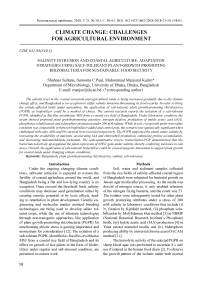Salinity intrusion and coastal agriculture: adaptation strategies using salt-tolerant plant-growth promoting rhizobacteria for sustainable food security
Автор: Sultana Shahnaz, Paul Sumonto C, Karim Muhammad Manjurul
Журнал: Региональные проблемы @regionalnye-problemy
Рубрика: Climate change: challenges for agricultural environment
Статья в выпуске: 3-1 т.21, 2018 года.
Бесплатный доступ
The salinity level in the coastal ecosystem and agricultural lands is being increased gradually due to the climate change effect, and Bangladesh is no exception to suffer salinity intrusion threatening its food security. In order to bring the salinity-affected lands under agriculture, the application of salt-tolerant, plant growth-promoting rhizobacteria (PGPR) as biofertilizer could be a method of choice. The current research reports the isolation of a salt-tolerant PGPR, identified as Bacillus aryabhattai MS3 from a coastal rice field of Bangladesh. Under laboratory condition, the strain showed profound plant growth-promoting activities: nitrogen fixation, production of indole acetic acid (IAA), phosphorus solubilization and siderophore production under 200 mM salinity. While in soil, rice growth under non-saline condition was comparable in between biofertilizer-added and control pots, the scenario was statistically significant when challenged with salts, 46% and 8% survival were recorded respectively...
Bangladesh, plant growth-promoting rhizobacteria, salinity, salt-tolerance
Короткий адрес: https://sciup.org/143165319
IDR: 143165319 | DOI: 10.31433/1605-220X-2018-21-3(1)-58-61
Список литературы Salinity intrusion and coastal agriculture: adaptation strategies using salt-tolerant plant-growth promoting rhizobacteria for sustainable food security
- Bates L, Waldren R, Teare I (1973) Rapid determination of free proline for water-stress studies. Plant and soil 39(1): 205-207
- Beecher DJ, Wong A (1994) Identification of hemolysin BL-producing Bacillus cereus isolates by a discontinuous hemolytic pattern in blood agar. Appl Environ Microbiol 60(5): 1646-1651
- Brahmaprakash G, Sahu PK (2012) Biofertilizers forsustainability. J Indian Institute Sci 92(1): 37-62
- Gordon SA, Weber RP (1951) Colorimetric estimation of indoleacetic acid. Plant Physiology 26(1): 192-195
- He Z, Honeycutt CW (2005) A modified molybdenum blue method for orthophosphate determination suitable for investigating enzymatic hydrolysis of organic phosphates. Communications in Soil Science and Plant Analysis 36(9-10): 1373-1383
- Lowry OH, Rosebrough NJ, Farr AL, Randall RJ (1951) Protein measurement with the Folin phenol reagent. J Biol Chemistry 193(1): 265-275
- Mandre M, Tullus H, Kloseiko J (2002) Partitioning of carbohydrates and biomass of needles in Scots pine canopy. Zeitschrift fur Naturforschung 57(3-4): 296-302
- Nautiyal CS, Srivastava S, Chauhan PS, Seem K, Mishra A, Sopory SK (2013) Plant growth-promoting bacteria Bacillus amyloliquefaciens NBRISN13 modulates gene expression profile of leaf and rhizosphere community in rice during salt stress. Plant Physiology and Biochemistry 66: 1-9
- Rao KM, Sresty T (2000) Antioxidative parameters in the seedlings of pigeonpea (Cajanus cajan (L.) Millspaugh) in response to Zn and Ni stresses. Plant Science 157(1): 1 13-128
- Sadasivam S, Manickam A (1997) Estimation of chlorophyll. Biochemical methods. New Age International Publishers: 190
- Schwyn B, Neilands J (1987) Universal chemical assay for the detection and determination of siderophores. Analytical Biochemistry 160(1): 47-56
- Tiwari S, Singh P, Tiwari R, Meena KK, Yandigeri M, Singh DP, Arora DK (2011) Salt-tolerant rhizobacteria-mediated induced tolerance in wheat (Triticum aestivum) and chemical diversity in rhizosphere enhance plant growth. Biology and Fertility of Soils 47(8): 907


